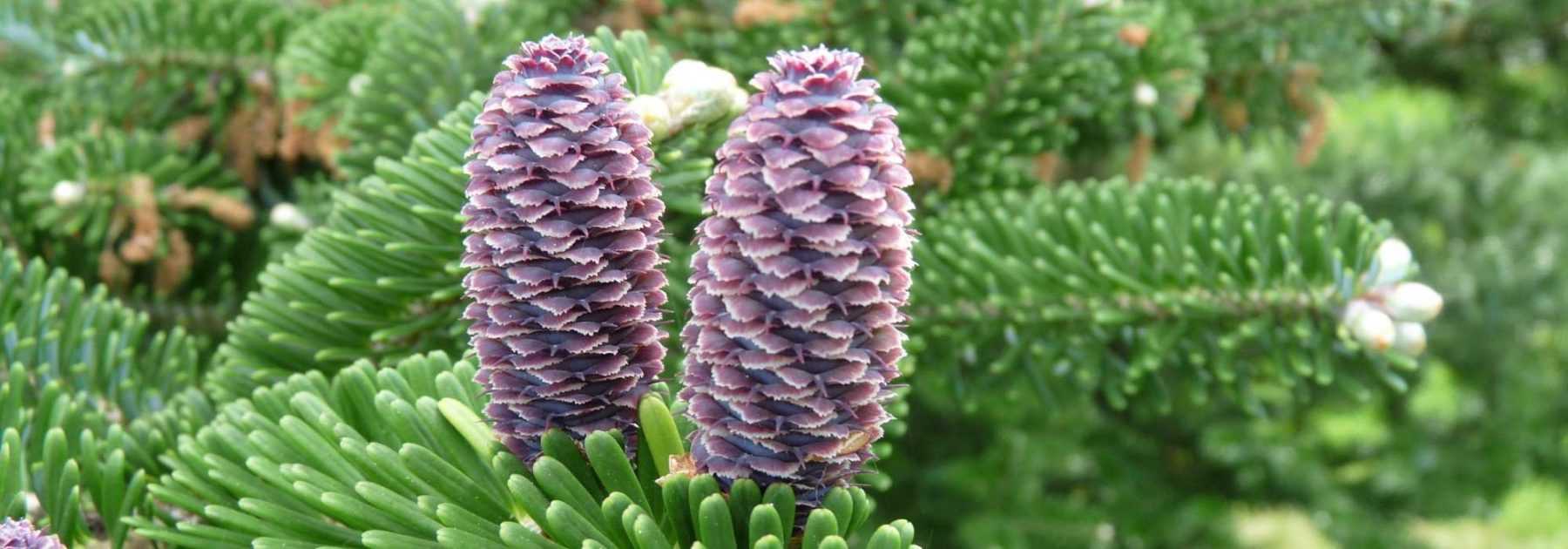
Fir, Abies: planting, pruning and care
Contents
The fir tree or Abies, in a few words
- Firs, scientifically known as Abies, are resinous evergreen conifers with a pyramidal habit,
- They typically populate cold, humid high-altitude forests or coastal areas.
- They feature soft, fairly short needles or thorns, arranged in two ranks or in a brush-like pattern, with two white stripes on the underside, as well as upright cones, tinged with purple in the case of the Korean fir.
- Usually large in size, there are many types of slow-growing, low-vigour firs that are highly ornamental and truly easy to cultivate in well-drained soil, sheltered from scorching sun.
Our expert's word
The lofty and noble fir tree, known by the Latin name Abies, remains the cornerstone of a successful Christmas atmosphere, exemplified by the Nordmann Fir. Its verticality symbolises the connection between earth and sky, celebrating renewal, as its cutting originally coincided with the winter solstice in Celtic tradition.
These evergreen conifers, with their slow growth, have the advantage of retaining their needles longer than the common spruce (Picea abies) when displayed indoors. Unlike spruces, the often flat branches of firs bear soft, flexible needles, pleasant to the touch, and upright cones, whereas spruces have prickly needles arranged in a spiral around the twigs and pendulous cones. Firs are adorned with aromatic needles ranging from dark green, as seen in Abies nordmannianna or Abies omorika, to bluish-grey, as in the noble fir (Abies procera, syn. nobilis). The cones are highly decorative, particularly in the Korean Fir, a modest-sized fir with a bushy habit, reaching 9 m in height and producing cones from a young age, displaying a striking violet-blue hue.
Firs generally exhibit slow growth, with a few exceptions like the Silver Fir (Abies alba), whose initially sluggish growth suddenly accelerates after its 6th year, reaching 1 m per year to form a tree up to 45 m tall. The Giant Fir (Abies grandis) is a “phenomenon,” capable of growing 16 m in 20 years and soaring to 90 m in height on Vancouver Island. The cultivars available are modest in size, ranging from 0.50 to 6 m tall, with varied habits—bushy, globose, conical, or pyramidal.
Firs are typically very hardy and thrive in cool conditions, which they find in high-altitude regions or coastal areas. Easy to cultivate in the garden, they generally require fresh, deep, well-drained soil and a sunny or partially shaded position. Aphids produce a honeydew on their needles that bees adore, turning it into an excellent honey. With few exceptions, firs tolerate pollution and extreme heat poorly.
Description and botany
Botanical data
- Latin name Abies
- Family Pinaceae
- Common name Colorado fir, Spanish fir, Silver fir, Vosges fir
- Flowering between April and May
- Height between 0.30 and 90 m
- Exposure sun or partial shade
- Soil type any deep, cool and well-drained soil, sometimes even calcareous
- Hardiness Excellent to moderate (-34 to -15 °C)
The genus Abies comprises nearly fifty species of evergreen conifers from the Pinaceae family, which also includes Pines and Spruces. The Douglas fir belongs to a different genus Pseudotsuga menzieisii, recognisable by its pendulous cones with three-pointed bracts. Abies are generally imposing trees, identifiable from a distance by their slender conical silhouette and elongated cones standing upright at the branch tips, rather than hanging down as in the Picea or Pseudotsuga genera.
Most firs live in high-altitude areas with cool or cold climates or near the sea, such as the grand fir (Abies grandis) and noble fir (Abies procera), exclusively in the Northern Hemisphere, particularly in China and western North America. However, some species can be found at the tops of mountains in tropical zones of Central America and Southeast Asia, along with a few rare species perfectly adapted to drought like the Spanish fir (Abies pinsapo) and the Greek fir (Abies cephalonica).
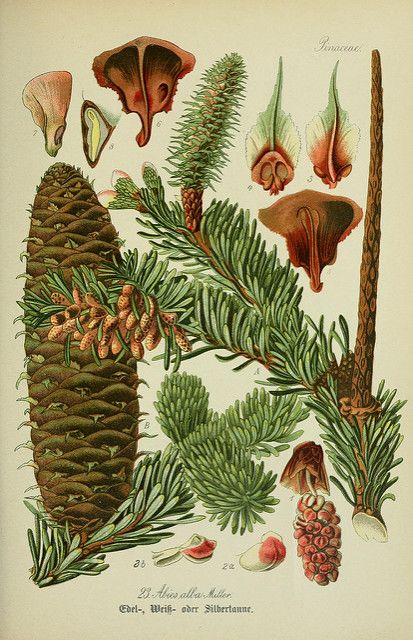
Abies alba – botanical illustration
The cylindrical trunk of firs is smooth, grey and dotted with resin blisters until the bark hardens with age. The branches, arranged in regular whorls around the trunk, create the conical silhouette so prized for showcasing Christmas decorations. Fir buds are generally rounded. The longevity of firs often exceeds 2 or 3 centuries, though growth is typically slow during the first 10 years. It then accelerates, except in dwarf varieties cultivated for ornamental gardens.
Fir needles are short leaves (1 to 7 cm long) flat and firm but not sharp, with blunt or sometimes notched tips, most often arranged in two ranks and featuring two white bands of stomata (removable cells facilitating gas exchange) on the underside. However, Abies pinsapo, koreana and basalmea are exceptions with their short, brush-like needles arranged all around the shoot and white bands on both sides. Abies bracteata, native to a small area of California, is an unusual species with long, sharp needles and buds as pointed as those of beech trees. The grey-blue hues are often highly sought after and result from selections among wild populations, such as in the Colorado fir (Abies concolor), noble fir (Abies procera) or Spanish fir (Abies pinsapo).
Handy tip to distinguish a spruce shoot from a fir shoot: Pull on a needle: if a piece of bark comes away, it’s a spruce; if a neat, perfectly round scar remains on the shoot, it’s a fir.
Fir flowering is monoecious, the male catkins yellowish, greenish or reddish and laden with pollen, bloom in April or May near the base of the tree on one-year-old shoots. The female flowers or conelets, located on the upper branches, form upright cylindrical cones after fertilisation. These cones detach or disintegrate scale by scale under summer drought or squirrel activity, leaving an upright axis on the shoot. The cones are sticky, exuding resin droplets when ripe, and take a year to mature. They feature more or less prominent bracts, particularly long and slender in Abies bracteata, giving them a hedgehog-like appearance. The triangular seeds are winged and have a short germination period.
Fir is prized for its white wood, easy to work, suitable for construction, joinery or paper pulp. Vosges turpentine is extracted from the resin of the silver fir (Abies alba), along with an essential oil from its needles used to treat respiratory infections.
Fir honey is highly aromatic and balsamic with a slight resinous scent.
Read also
How to Take Cuttings from Conifers?The main varieties of fir
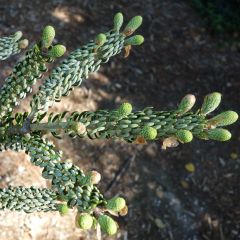
Abies koreana Silberlocke - Korean Fir
- Height at maturity 3,50 m
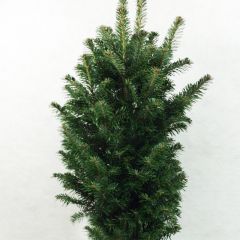
Abies alba Pyramidalis - Dwarf White Fir
- Height at maturity 2,50 m
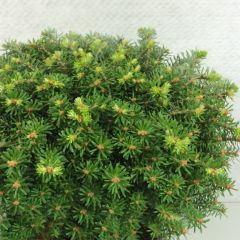
Abies koreana Nadelkissen - Korean Fir
- Height at maturity 35 cm
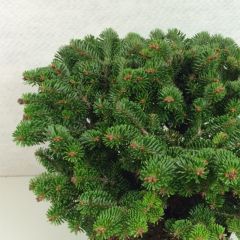
Abies nordmanniana subsp. nordmanniana Münsterland - Fir
- Height at maturity 30 cm
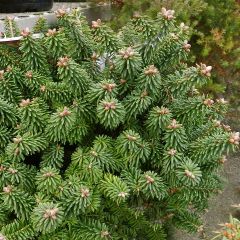
Abies balsamea Piccolo
- Height at maturity 45 cm
Discover other Abies
View all →Available in 2 sizes
Available in 1 sizes
Available in 1 sizes
Available in 1 sizes
Available in 1 sizes
Available in 1 sizes
Available in 2 sizes
Available in 1 sizes
Available in 1 sizes
Available in 2 sizes
Planting
Where to plant the fir tree?
Fir trees grow in any ordinary, deep, cool, well-drained soil. However, some species do not tolerate limestone such as nobilis and grandis, unlike nordmaniana and pinsapo, for example. The latter even accept dry soils and make very fine specimens in the south of France.
The Nikko fir, Abies homolepis, is one of the few to tolerate urban pollution and drought. It rarely exceeds 5 to 10 m in height and produces bright purple young cones from an early age, like koreana, a highly ornamental but more demanding species.
When to plant?
Prefer planting in autumn between October and December for good establishment before facing summer drought.
How to plant?
This plant is easy to grow if you take minimal care during planting. The fir tree is planted from a balled or container-grown young plant but never from bare roots.
- Soak the root ball in a bucket of water to moisten it well and loosen the edges slightly to prevent the roots from circling, but without disturbing them too much.
- Dig a hole 0.60 to 1 m wide and 0.50 to 0.70 cm deep and aerate the surrounding soil with the teeth of a garden fork.
- In heavy soil, add a few spadefuls of sand and gravel to ensure good drainage around the roots.
- It is not advisable to add manure or compost as the plant is content with fairly poor soil. Add crushed horn if the soil is poor.
- Plant only 5-6 cm below soil level.
- Install a stake at an angle or 3 vertical stakes to support the plant in case of strong winds.
- Replace the soil and firm lightly, forming a basin.
- Water generously and mulch if necessary.
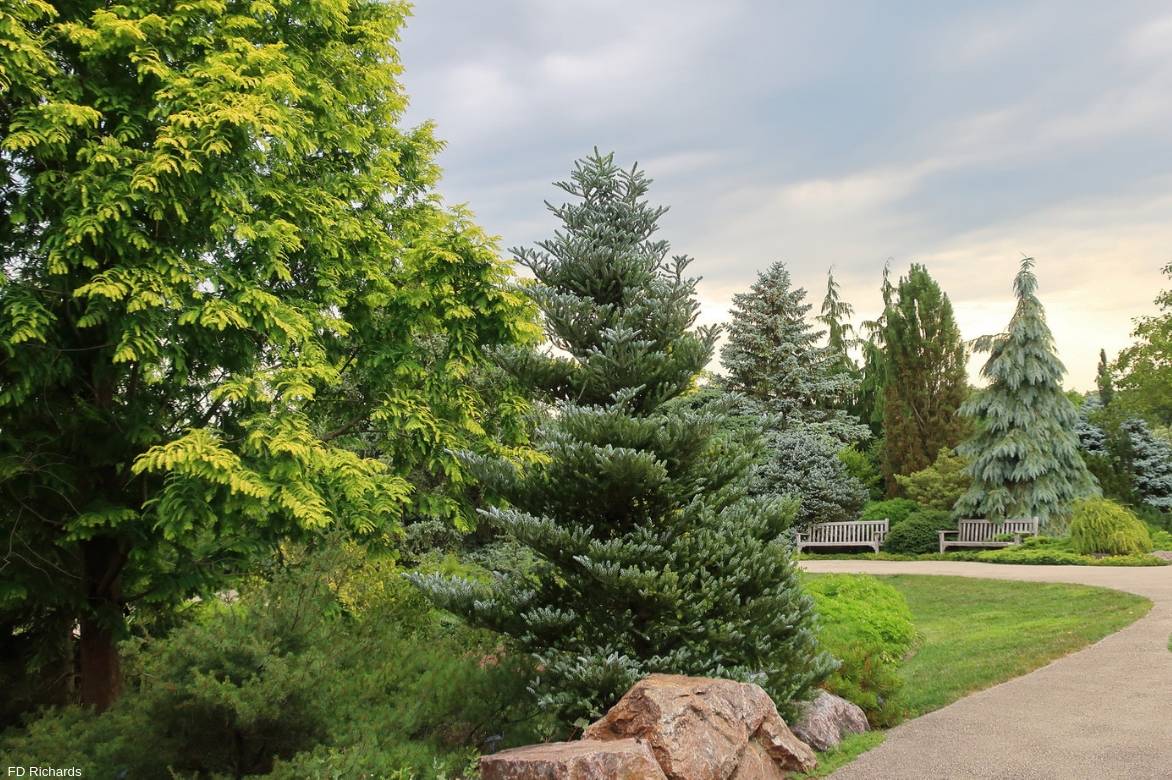
Metasequia glyptostroboides ‘Gold Rush’, Abies koreana ‘Silver Show’ (variety similar to ‘Silberlocke’) and Picea engelmannii ‘Blush’s Lace’ in the background at the Chicago Botanical Garden
Maintenance and pruning
Fir trees should not be pruned in order to maintain their beautiful, characteristic conical habit. However, the lower branches may wither due to lack of light, and you can anticipate this by gradually raising the crown, except for ball-shaped, spreading or bushy forms. It is not forbidden to balance the silhouette by cutting a few shoots in October, bearing in mind that the tree does not produce new shoots on its old wood.
Fir trees are susceptible to adelgids, which cause small galls on the shoots and especially honeydew on the foliage, much appreciated by bees. You may spray a mineral oil on the trunk in late winter. Rust and spider mites can occur in dry climates. Fir trees may also succumb to honey fungus in poorly drained soil.
Propagation
The simplest method of propagation is to sow the species types, bearing in mind that the blue-needled selections often won’t necessarily be reproduced in the offspring. Propagation by cuttings with a heel from lateral shoots is practised on dwarf varieties or grafting, but this is a job for professionals.
Propagation by cuttings
Prepare a deep pot by filling it with compost mixed with sand.
- Take cuttings from the tips of lateral shoots that have ripened by pulling to obtain a heel.
- Remove the needles near the base of the cutting.
- Insert them two-thirds of their length, ensuring they don’t touch each other.
- Gently firm around them to eliminate air pockets and ensure good contact between the compost and the cutting.
- Place them in a warm, humid environment with high humidity.
- In autumn, separate the rooted cuttings and plant them in deep pots.
- Plant your young plants in the following autumn directly in the ground.→ Discover our tutorial: How to take cuttings from conifers?
Sowing
- Sow the seeds after harvest in autumn in a sandy mix or stratify them in cold conditions for spring sowing.
- Maintain good moisture levels.
- Transplant the young plants in September.
Uses and Associations in the Garden
Growing dwarf varieties or very slow-growth bushes in deep pots such as Abies balsamea Nana or even koreana is possible. These are naturally well-suited to small gardens with a humid atmosphere, like coastal or mountainous areas. The delicate bluish or lime-green spring foliage, adorned with brightly coloured cones as seen in Korean firs, works wonders in a rock garden where graphic shapes – spherical, conical or spreading – can shine. This could be an alpine rockery planted with vividly coloured ground-cover perennials like aubrietas or cerastiums, or a rocky outcrop adorned with heathers.
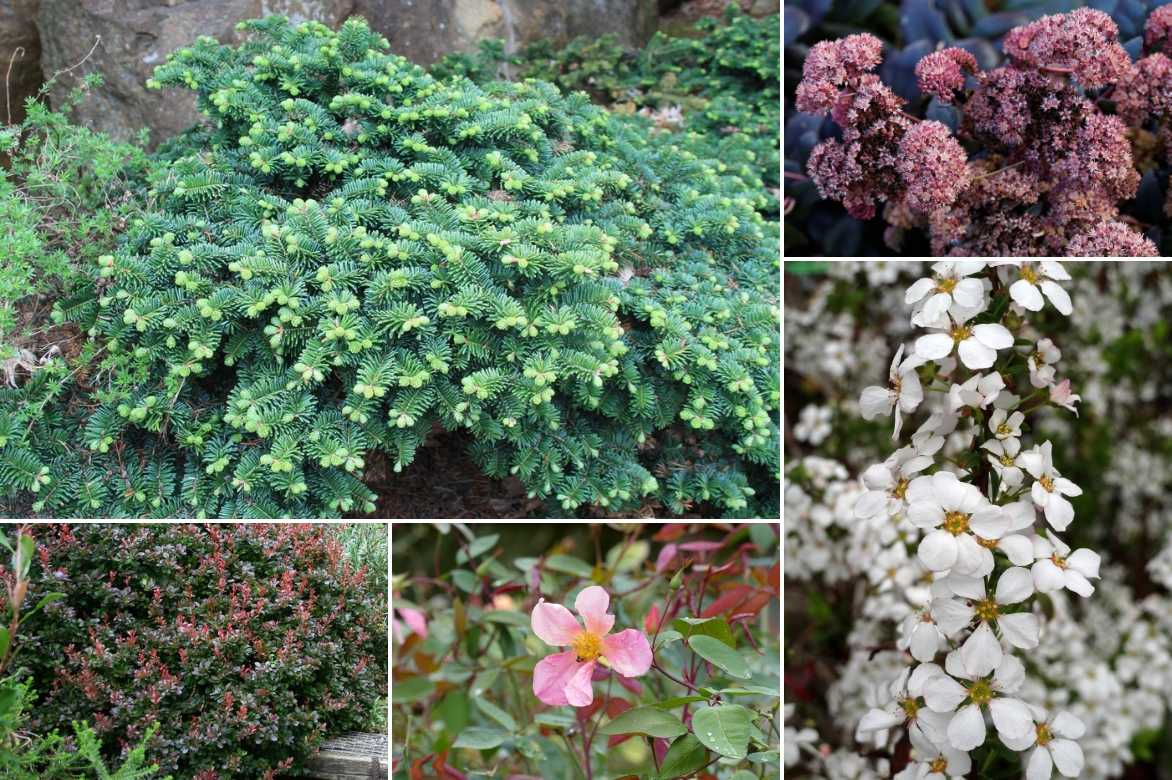

A planting scheme idea: Abies balsamea ‘Nana’, Sedum ‘Purple Emperor’, Spirea thunbergii ‘Fujino Pink’, Rosa chinensis ‘Mutabilis’ and Berberis thunbergii ‘Atropurpurea’
Dwarf firs, whether combined with other small rockery conifers or not, can beautifully frame small rose bushes, flowering shrubs like azaleas, clumps of peonies, or even wild ornamental grasses with wonderfully complementary temperaments. These are plants of strong character, blessed with great longevity and requiring no maintenance beyond thorough watering during prolonged droughts.
The slightly more vigorous conical specimens can be planted as standalone features, in threes, or in large windbreak hedges. These highly distinctive plants provide lasting structure to borders, mark pathways, edge terraces, and easily substitute for the strong presence of pruned boxwood.
Did you know?
The Latin name Abies likely has a pre-Indo-European origin and is found in most Romance languages (abeto in Spanish, abete in Italian) except in Romanian and French. The word “fir” comes from the Gaulish sapo and is at the origin of the name Savoie, meaning “the forest of firs”. The famous brand SPAR refers to the fir tree in Dutch, hence its logo in the shape of a stylised fir.
To go further
Discover:
- Our range of fir trees
- Fir Trees: Explore the Benefits of Different Varieties.
- Our video: Korean Fir: Highly Original Needles
- Check out our tutorial: How to Take Cuttings from Conifers?
Frequently asked questions
-
What to do with my Christmas tree sold with or without its root ball?
The Christmas trees sold for the festive season are generally large, pyramidal-shaped trees that are difficult to integrate and grow in an urban garden. This is why it is always tricky to plant a Christmas tree such as the Nordmann fir or the noble fir, purchased with its root ball, in your garden—especially after it has been kept in a heated indoor environment. Some retailers take them back to turn them into compost. It's worth noting that growing fir trees for festive purposes has a rather positive environmental impact compared to buying an artificial tree made from petroleum, especially since young plantations absorb more carbon dioxide than ancient forests. If you wish to plant your Christmas tree in the ground, ensure it receives sufficient light and a cool atmosphere to prevent it from drying out. Ideally, move it outside at night or keep it outdoors until planting.
- Subscribe!
- Contents
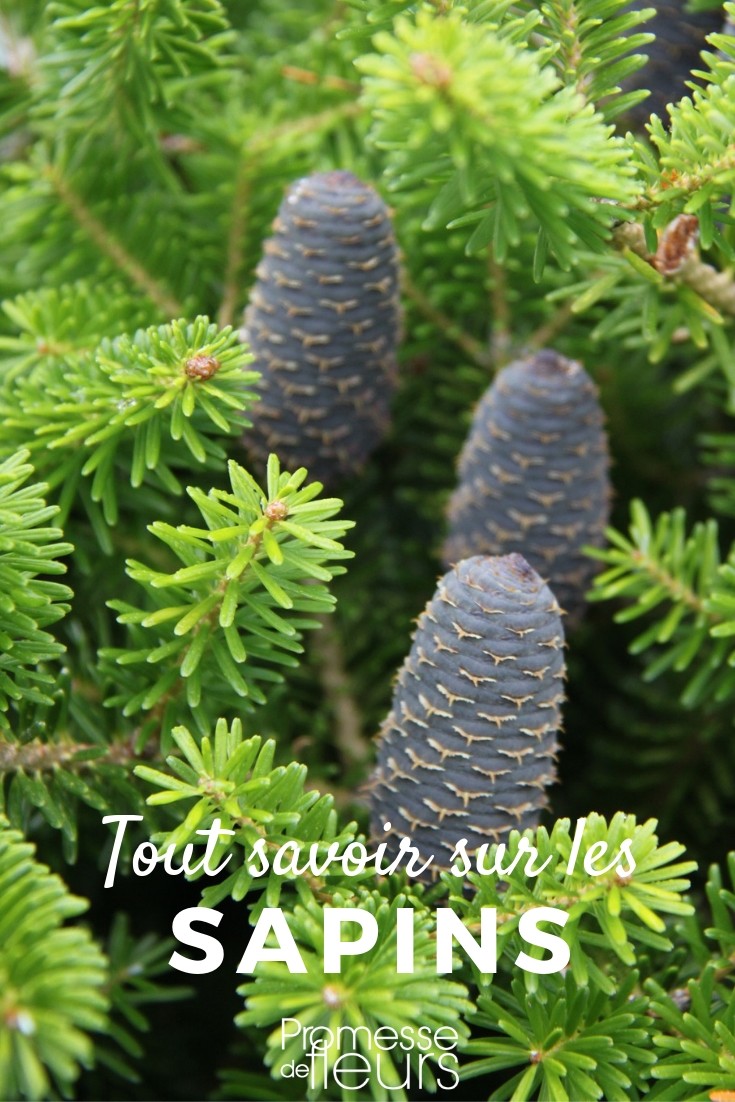


































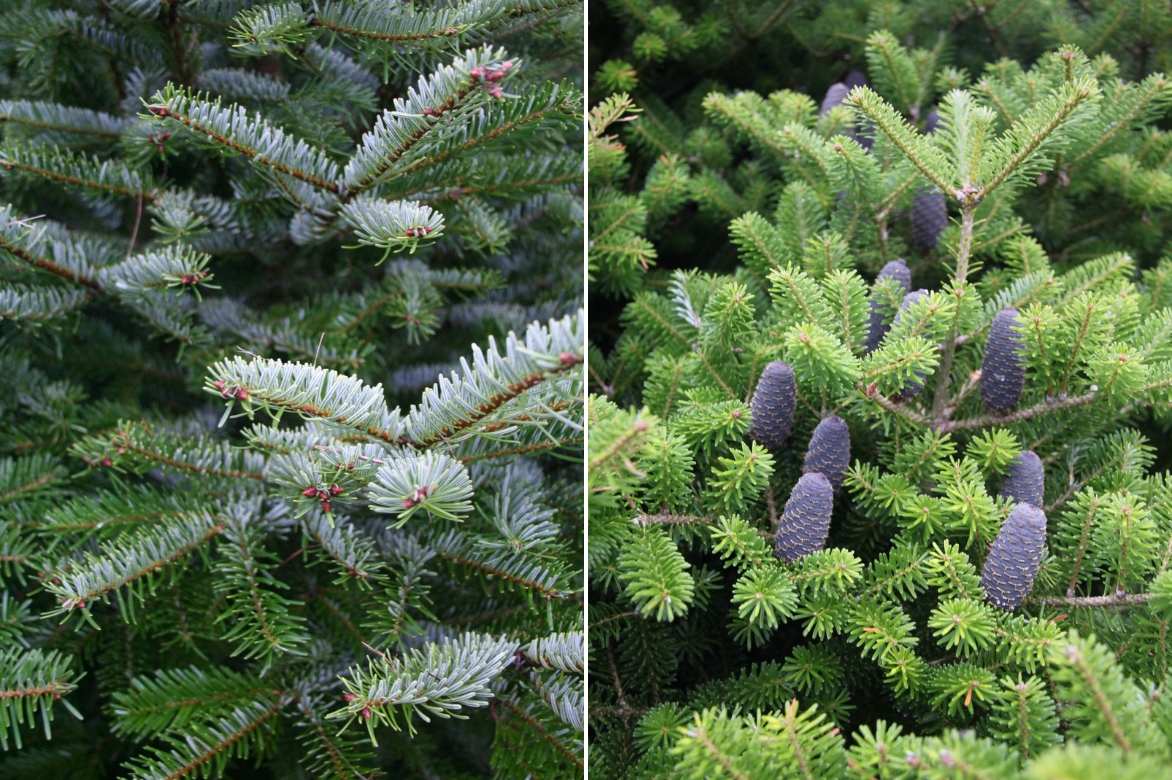
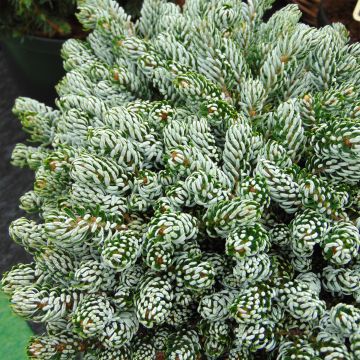
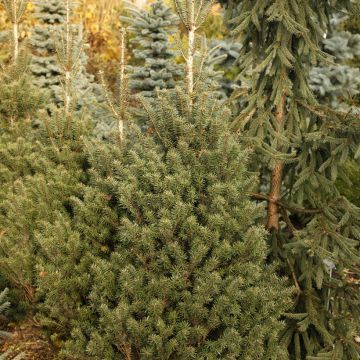


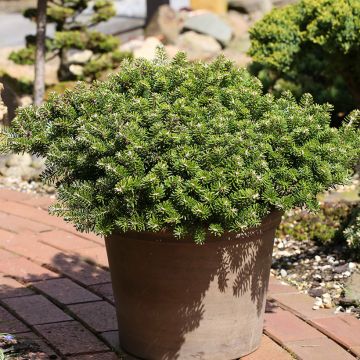

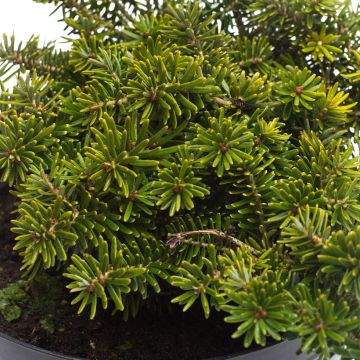


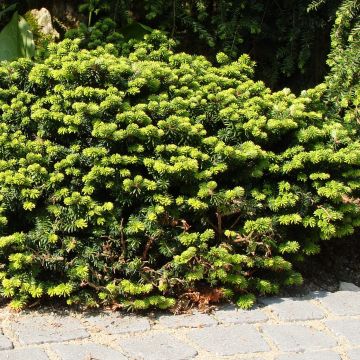
Comments